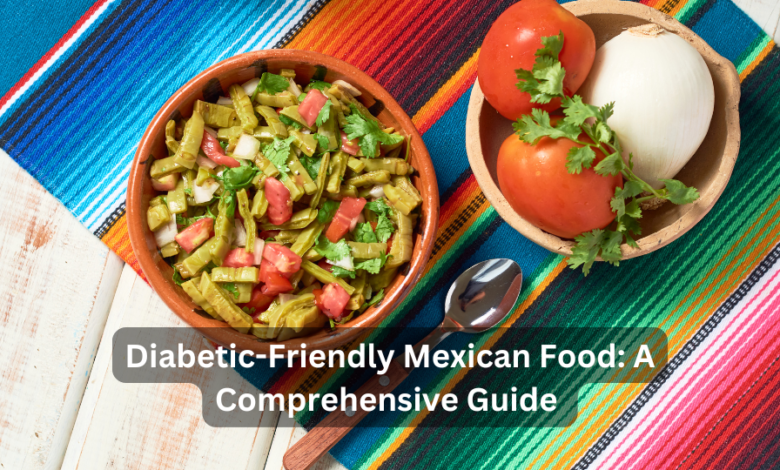Diabetic-Friendly Mexican Food: A Comprehensive Guide

Mexican cuisine is celebrated worldwide for its bold flavors, diverse ingredients, and rich culinary heritage. For individuals with diabetes, enjoying this vibrant cuisine while managing blood sugar levels might seem challenging. However, with mindful choices and a few adjustments, it is entirely possible to indulge in delicious diabetic-friendly Mexican food. This guide will explore how to savor the taste of Mexico while keeping blood sugar levels in check, offering tips, recipes, and healthier alternatives to traditional dishes.
Understanding Diabetes and the Role of Nutrition
Before diving into specific food choices, it’s crucial to understand the role of nutrition in diabetes management. Diabetes is a condition that affects how the body regulates blood sugar (glucose). Carbohydrates, fats, and proteins all impact blood sugar levels differently. For diabetics, focusing on low-glycemic index (GI) foods—those that release glucose slowly—can help in maintaining stable blood sugar levels. Mexican cuisine offers a range of ingredients that fit well into a diabetic-friendly diet, provided they’re selected carefully.
Top Ingredients in Mexican Food for Diabetics
1. Beans (Frijoles)
Beans are a staple in Mexican cuisine and are an excellent source of fiber and plant-based protein. They have a low glycemic index, meaning they don’t cause rapid spikes in blood sugar levels. Black beans, pinto beans, and kidney beans are great choices for diabetics.
- Health benefits: Beans are rich in antioxidants, folate, and iron, making them a nutritious addition to any meal. The fiber content helps in slowing glucose absorption, promoting steady blood sugar levels.
2. Avocado (Aguacate)
Avocados are packed with healthy fats (monounsaturated fats), which are beneficial for heart health and blood sugar control. They contain minimal carbohydrates and are low on the glycemic index, making them a perfect food for diabetics.
- Health benefits: Avocados are a rich source of vitamin E, potassium, and fiber. Incorporating avocados in meals can help in reducing insulin resistance and keeping hunger at bay for longer periods.
3. Tomatoes (Tomate)
Tomatoes are a key ingredient in Mexican salsas, stews, and sauces. They have a low glycemic index and provide essential nutrients like vitamin C, potassium, and lycopene (an antioxidant).
- Health benefits: Consuming tomatoes can help lower inflammation and support heart health, two areas of concern for diabetics.
4. Peppers (Chiles)
Peppers, both hot and mild, are commonly used in Mexican dishes. Bell peppers, jalapeños, and poblano peppers are low in carbohydrates and high in antioxidants, making them a smart choice for those with diabetes.
- Health benefits: Peppers are rich in vitamin A and vitamin C. Capsaicin, the compound that gives hot peppers their spice, has been shown to improve insulin sensitivity.
5. Whole Grains (Granos Enteros)
In Mexican cuisine, whole grains like corn (maize), brown rice, and quinoa are often used. Opting for whole-grain tortillas and brown rice over refined grains helps in managing blood sugar levels more effectively.
- Health benefits: Whole grains provide fiber and are digested more slowly, preventing sudden blood sugar spikes. They also promote gut health and help maintain a healthy weight.
Diabetic-Friendly Mexican Dishes: What to Eat and What to Avoid
While traditional Mexican dishes can be carb-heavy, with options like refried beans, fried tortillas, and sugary drinks, there are healthier alternatives that don’t compromise on flavor. Here are some diabetic-friendly Mexican dishes and modifications:
1. Tacos
- Healthy alternative: Choose corn tortillas over flour tortillas. Corn tortillas are lower in carbohydrates and calories. Opt for grilled meats like chicken, shrimp, or fish instead of fried options like chicharrón or carnitas.
- Fillings: Load your tacos with vegetables, guacamole, and salsas that are made from fresh ingredients. Avoid toppings like sour cream and cheese, which add unhealthy fats.
2. Enchiladas
- Healthy alternative: Enchiladas can be made diabetic-friendly by using whole wheat tortillas or low-carb tortillas. Instead of drowning them in cheese, opt for a light sprinkle and use a flavorful tomato-based sauce.
- Protein choice: Choose lean meats like grilled chicken or black beans for a filling, nutritious option. Avoid heavy fillings like processed meats or refried beans.
3. Fajitas
- Healthy alternative: Fajitas are a great option for diabetics when prepared with lean proteins (like chicken, shrimp, or tofu) and plenty of sautéed vegetables like bell peppers and onions. Skip the sour cream and opt for guacamole instead.
- Serving tip: Serve the fajitas with lettuce wraps or whole wheat tortillas for a lower-carb meal.
4. Mexican Salads
Salads are always a good option for a healthy meal. A traditional Mexican salad with greens, grilled vegetables, avocado, and lean proteins can be a nutritious and delicious choice.
- Dressings: Be cautious with dressings that are high in sugar. Stick to simple dressings like a squeeze of lime juice, olive oil, or a light vinaigrette.
5. Salsas and Guacamole
Salsas made from fresh ingredients like tomatoes, onions, cilantro, and lime are a low-calorie and nutritious addition to any meal. Guacamole, rich in healthy fats, can also be enjoyed in moderation.
- What to avoid: Stay away from store-bought salsas that contain added sugars or preservatives.
Healthy Mexican Food Preparation Tips
Cooking methods play a crucial role in making Mexican food healthier and more suitable for diabetics. Below are a few tips for preparing diabetic-friendly Mexican meals:
1. Opt for Grilling or Baking Instead of Frying
Traditional Mexican cuisine often includes fried items like chimichangas and tostadas, which can be high in unhealthy fats. Instead, try grilling or baking your food to reduce calorie and fat intake.
2. Use Fresh, Whole Ingredients
The best way to control sugar and fat content is by using fresh, whole ingredients. Skip processed foods and sauces that may contain hidden sugars and unhealthy fats. Prepare your own salsas, guacamole, and bean dips to ensure they’re free from unwanted additives.
3. Watch Your Portions
While enjoying diabetic-friendly Mexican food, portion control is essential. Opt for smaller portions of high-carb items like rice and tortillas, and balance your meal with plenty of vegetables and lean proteins.
4. Incorporate Fiber-Rich Foods
Adding fiber-rich foods like beans, whole grains, and leafy greens helps slow down digestion, leading to more stable blood sugar levels.
Drinks: Beverages to Enjoy and Avoid
Mexican cuisine is also famous for its wide array of beverages. However, many traditional drinks can be high in sugar. Here are some diabetic-friendly drink options:
1. Horchata
While traditional horchata can be loaded with sugar, you can make a healthier version at home by using unsweetened almond milk, a small amount of stevia or monk fruit sweetener, and cinnamon.
2. Agua Fresca
Instead of the sugar-laden versions often found in restaurants, try making your own agua fresca by blending cucumber, lime, and mint with water and a natural sweetener like stevia. This refreshing drink is hydrating and low in sugar.
3. Avoid Sugary Drinks
Stay away from drinks like margaritas, piña coladas, and sugary sodas. These are high in added sugars and can cause spikes in blood sugar levels. Opt for water infused with citrus or herbs as a flavorful alternative.
Desserts: Healthier Options to Satisfy Your Sweet Tooth
Mexican desserts are often rich and sweet, but there are diabetic-friendly alternatives:
1. Fresh Fruit with Lime and Chili
Fresh fruit like mangoes, pineapples, and papayas can satisfy your sweet tooth without spiking blood sugar levels. Sprinkle them with a little lime juice and chili powder for a traditional Mexican touch.
2. Sugar-Free Flan
A diabetic-friendly version of the classic Mexican flan can be made using sugar substitutes like erythritol or stevia. It’s just as creamy and delicious but without the added sugar.
3. Churro Alternatives
Instead of traditional churros, which are fried and dusted with sugar, try making baked churros using whole wheat flour and a sugar substitute for a healthier option.
Mexican Food Dining Out: How to Make Smart Choices
When dining out at a Mexican restaurant, navigating the menu can be tricky. Here’s how to make smart choices:
1. Skip the Chips
While tempting, restaurant-style tortilla chips are often fried and high in carbohydrates. Ask for a side of vegetables or whole-grain tortillas to enjoy with your salsas and guacamole instead.
2. Choose Lean Proteins
Opt for grilled dishes like chicken, shrimp, or steak fajitas without the rice and beans. Ask for extra vegetables to bulk up your meal without the added carbs.
3. Modify the Menu
Don’t be afraid to ask for substitutions. Request whole wheat tortillas, no cheese, or sauces on the side to better control what goes into your meal.
Conclusion: Enjoying Mexican Cuisine the Diabetic-Friendly Way
With mindful choices, it’s entirely possible to enjoy the rich and flavorful world of Mexican cuisine while managing diabetes. By focusing on whole, nutrient-dense ingredients, opting for healthier cooking methods, and practicing portion control, you can create a diabetic-friendly Mexican dining experience that’s as satisfying as it is healthy. Always consult with a healthcare provider for personalized dietary advice, and enjoy the vibrant flavors of Mexico without compromising on your health.
For more detailed information on managing diabetes with a balanced diet, visit American Diabetes Association for up-to-date recommendations and guidelines.
